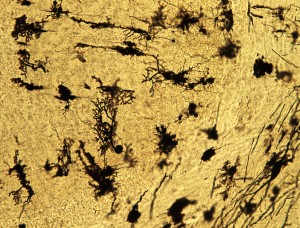The lab uses a well-characterized animal model of mitochondrial disease, the Ndufs 4KO mice, lacking a subunit of the mitochondrial complex I, to identify vulnerable populations. Like human patients, Ndufs4KO mice present brain lesions restricted to specific brain areas and die at a young age. Among these, the vestibular nucleus in the brainstem is primarily affected and our previous results have shown that it is a main contributor in the fatal phenotype of Ndufs4KO by altering autonomic control responses such as control of breathing. Currently, the lab is focusing on determining the molecular identity of these vulnerable vestibular neurons by combining mouse genetics and innovative molecular biology tools, such as cell-specific ribosomal profiling (RiboTag), as well as developing novel molecular biology methods, to elucidate the signaling changes in these neuronal populations.
4KO mice, lacking a subunit of the mitochondrial complex I, to identify vulnerable populations. Like human patients, Ndufs4KO mice present brain lesions restricted to specific brain areas and die at a young age. Among these, the vestibular nucleus in the brainstem is primarily affected and our previous results have shown that it is a main contributor in the fatal phenotype of Ndufs4KO by altering autonomic control responses such as control of breathing. Currently, the lab is focusing on determining the molecular identity of these vulnerable vestibular neurons by combining mouse genetics and innovative molecular biology tools, such as cell-specific ribosomal profiling (RiboTag), as well as developing novel molecular biology methods, to elucidate the signaling changes in these neuronal populations.